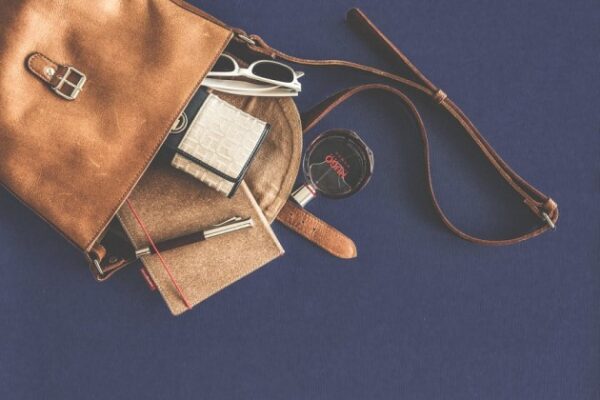Humans have needed to carry their belongings and tools for a very long time. The Rock art found in Australia of the ancient prehistoric age shows a picture of a warrior-like figure holding a satchel in his arm. We can see the use of bags from a 5300 old mummy of the iceman that carried a backpack and a pouch in his belt. This shows that early humans also carried bags to keep their belongings. If we go through the pictures of ancient Roman soldiers, we would notice them carrying a satchel bag. These bags were made out of goatskin.
Ancient History provides great evidence of humans using animal skin bags, which are still being used with little or no innovation. The messenger bags that we see in the shops today are the same shape as used by Romans in the ancient days. We still use leather handbags made out of animal skin as the people in the old days did. However, the animals slaughtered for the skin during those days were few, whereas today the leather bags have evolved into the most exquisite and branded accessory carried by only the selected people. Of course, leather has become a modern luxury, skilfully crafted by hand into the most unique designs patented by the brands. Leather bags today are not so different than those of the early historical era. One element that runs through the history of mankind until this date is the craftsmanship of leather handbags and accessories.
Making of leather
There are several types of leather bags available and have evolved since the early ages of mankind. Like a patent, gold, metallic, carved, and hedgehog leather handbags. Italian handbags have always taken up position ahead of other leather handbags worldwide. Italian craftsmanship holds pride in linking themselves with the oldest leather crafters and produce exclusive pieces of fine and luxurious handbags. Let us look through the art of making leather handbags further in detail.
Making leather is a technical process that has to be followed with precision to prepare high-quality leather with the same finish every time. The journey of leather starts with an animal hide, going through the processing to end up as leather before it transforms into a beautiful leather bag, jacket or other accessories.
Leather has to go through the following four stages in order to come to its completion stage:
Preparing Animal Hide
Leather is made from the hide of almost any animal, like crocodiles, alligators, goats, pigs, sheep, and cane toad leather to name a few. Other animals that are valuable to produce the leather skin are python, ostrich, lizard, iguana, cobra, turtle, water buffalo, eel, and stingray and camel leather. However, cow leather is the most commonly used type to produce any product pertaining to leather. It is readily available due to the excessive use of meat, which leaves the cows to be the best candidate for the animal hide to be extracted. In fact, this saves the cows hide to go in waste. It is important to look for a blemish-free, high-quality hide for the manufacturing of products that revolve around perfection.
The skin is removed from the animal, and then the flesh and skin by hand or by the fleshing machine. After this, the height should be salted or put in salt brine. Apply the salt generously because this stops the skin from decomposing. Decomposition starts quicker than one can imagine, therefore the hide should be prepared right after it is salted. If the hide has hair sticking out, you would require removing the hair by dipping it into the calcium oxide solution, which is also called the lime bath.
After the bathing and soaking, the leather will become thicker and will require to be split into two layers. The upper part of the skin is used for high-quality products. This is because it has a full-grain structure making it tightly packed together, have greater durability.
Designing
The very first thing after knowing what leather is being used is the job of a designer. He has the task of designing and creating new models of leather handbags, taking inspiration from the latest trends, colors, and styles. However, the designer should not design his model based on just the latest trends. Their design should be based on the type of leather that is being used. He has to develop a design that collaborates with the quality of the leather that is being used. If the leather is from python or ostrich the softness and suppleness of the leather tend the designer to create a bag that is soft rather than more structured and firmer in design. Leather hides are not cheap, so prior planning in design is crucial in order to prevent time and money loss.
Leather Crafting
After the number of models is submitted by the designer, leather crafters decide which one is the most suitable for the new collection and whether the design would turn out well with the type of leather for which the designer has designed. After selecting the best appropriate design, the craftsmen move on to the very important part of the production process-making the prototype of the finished bag on paper. One person does not hold the responsibility of carrying out more than one or a few tasks all by himself. However, if that one person is experienced and is a specialist in the leather sector, they can take up more tasks at the same time. Usually, the creation of a prototype is entrusted to the expert in pattern making. They work according to the design drawn by the designer and transfer his ideas onto a paper model of the bag. This is the stage when the bag actually begins to take a shape.
Leather Cutting
Once the prototype is prepared and approved, the most important person to shape up the final product comes into the picture. Now the leather cutter skilfully cuts the selected leather into the shape that is required and prepares it for stitching. Leather cutting is one of the very intricate and accurate tasks which require extreme expertise of cutting and crafting, making use of every inch of leather. Here everything lies at his disposal, ensuring that nothing goes to waste and above all has an eye for detail to recognize any defects of the leather hide with which he is working. The slightest error can cause a lot of wastage and loss of money. The leather hides are extremely valuable and sometimes acquiring them requires a long wait. There is a huge weight of responsibly on the hands of the leather cutter. The cutter has to ensure that his cutting corresponds perfectly with the design provided by the designer, using the skins natural pattern and designs in the most optimized manner with the best art of stitching.
Stitching
Stitching is another skilful part of the making of quality and prestigious bag. The man who takes care of this part is known as the assembler. He is the one who puts together the various parts of a single bag, recreating the prototype paper model using the clean actual leather. Stitching is also a very intricate work and must be carried out with immaculate care and attention. The assembler needs to have a huge experience in hand stitching and with the simplest of sewing machines to produce fine stitching and symmetrical seems on the leather bag. His expertise is tested most of the crocodile or alligator skin bags which are too rigid and difficult to place every detail altogether. Leather is different from other fabrics and requires extreme precaution and care since one wrong stitch leaves a permanent mark. The final quality and face of the finished product are totally dependent on the assembler and his alertness in stitching.
Finishing
At this stage, the handbag is carefully inspecting for any loopholes to be corrected, and all the accessories and hardware are clamped in it. The buckled and zips are attached giving the bags final appearance. The finished handbag is carefully wrapped in a fine fabric pouch to be protected from any shipping scratches until it reaches the customer.
Conclusion
In the making of prestigious leather handbags, the quality of the material that is being used holds great importance. Apart from that the leather finish after it is prepared to be handed over to the cutter reflects in getting the best-finished products. However, the experience, expertise and the cautiousness within the leather handbag craftsmen is the biggest factor to produce the fine quality handbag apart from providing the best artisan workshop to these crafters. The patience and calmness within these people involved in the production are of the essence. Making a luxury product involves expensive genuine raw materials as well. Therefore, extreme care and patience are required in order to eradicate the minutest chance of any mistake and wastage to avoid extra problematic expenses.


















Be First to Comment